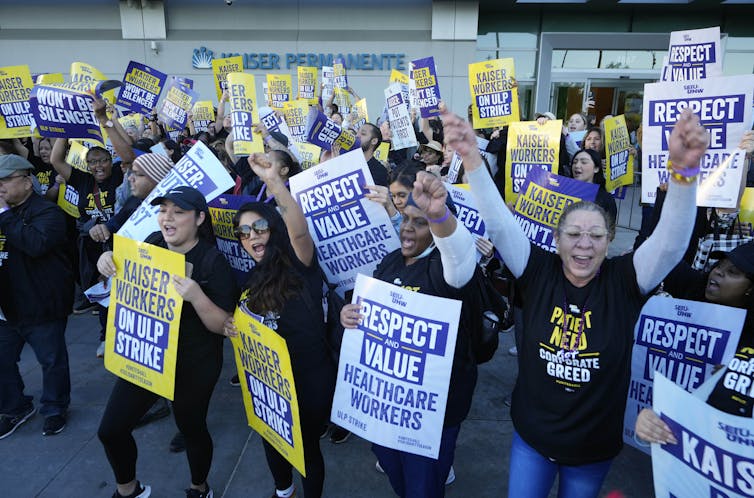
More than 75,000 Kaiser Permanente health care workers began a three-day strike in Virginia, California, Colorado, Washington state, Oregon and Washington, D.C., on Oct. 4, 2023, after company executives and eight unions representing aides, techs, support staff and other employees failed to agree on the terms of new contracts. This is the largest U.S. health care strike on record. In a statement it released when the walkout started, Kaiser asserted that it wanted to reach a deal soon with the striking workers.
Although hospitals and emergency rooms are still open during the strike, and Kaiser is making use of temporary workers, many of its noncritical services are temporarily closed or operating under reduced hours. The strike does not include any nurses unions or doctors.
The Conversation asked Michael McQuarrie, an Arizona State University sociologist who directs its Center for Work and Democracy, to explain why this strike is happening now and how labor actions like this can affect patient care.
1. Why is this historic strike happening now?
The two main reasons are concerns over staffing levels and practices and dissatisfaction with pay that hasn’t kept up with inflation and was too low to begin with.
Kaiser says its options are limited due to a national shortfall in all sorts of health care workers, including home health aides and nurse practitioners. Workers counter that higher pay and better working conditions would attract more applicants.
Health care workers have long worried that inadequate staffing is undercutting the quality of care for patients – this has been a central issue in contract negotiations and strikes for years. But the COVID-19 pandemic greatly exacerbated the problem.
At the same time, inflation has outstripped negotiated wage increases for Kaiser workers. Kaiser is currently offering some workers in Northern California and Washington state 4% annual raises for the four years covered by the new contract and lower raises for everyone else. The unions have rejected this offer, which they say would not make up for past inflation and would unnecessarily create different wage scales based on the region where workers are located.
2. Has Kaiser’s financial management played a role too?
Kaiser, which provides health care for 12.7 million Americans, took in US$95.4 billion in revenue in 2022 but ran a $1.2 billion operating loss that it attributed to “strong economic headwinds in the financial markets” – suggesting that its investments were to blame rather than its health care operations.
For 2021, Kaiser reported that it had about $56 billion in unrestricted cash and investments, excluding assets tied to employee and retiree pensions.
Kaiser’s profits in the first half of 2023 totaled about $3.4 billion, however. And with the exception of its losses in 2022, Kaiser has been consistently profitable for years.
Concerns over low worker pay are growing while Kaiser’s executive compensation is increasing. As of 2021, its CEO Gregory Adams was making more than $15.5 million a year in pay and “other” compensation.
3. But isn’t Kaiser a nonprofit – and does that mean it has any special obligations?
Like many health care systems, Kaiser is a nonprofit. This means it pays very little in taxes. In exchange for their special tax status, nonprofits are supposed to provide public benefits.
Nonprofits may make more money than they spend, but they can’t distribute profits to its shareholders. Nonprofit executive compensation must be “reasonable,” according to the Internal Revenue Service – although it can be hard to determine how much is too much.
4. Are there any precedents for this strike?
Health care strikes are not unusual, with more than 40 occurring in the past two years. However, the industry and the workforce are heavily fragmented, which means that these strikes tend to be relatively small.
In September 2022, the Minnesota Nurses Association took 15,000 members on strike over many of the same issues, such as staffing and inflation. That strike, which lasted three days, was the largest health care strike in U.S. history by that point in terms the number of workers involved.
Prior to that, the largest was probably another Minnesota strike in 2010, in which about 12,000 nurses walked off the job for 24 hours.
Kaiser has experienced much smaller strikes in the past, such as a walkout in 2015 of about 75 mental health clinicians.
5. How much are patients harmed during health care strikes?
It depends on the strike, but usually not much.
Critical care Kaiser facilities will remain open, though the strike will likely cause some delays in care due to short staffing and long lines.
Some appointments and elective procedures at the affected hospitals are being postponed, and nonessential functions like labs and radiology departments are temporarily closed or their hours are being reduced.
Nurses, who are very important bedside caregivers, are part of a different coalition of Kaiser unions. While they won’t be on strike, they may have to help cover work not being done by aides and other support staff who are on the picket lines.![]()
Michael McQuarrie, Director of the Center for Work and Democracy, Arizona State University
This article is republished from The Conversation under a Creative Commons license. Read the original article.
Please support and visit The Brooks Blackboard's website for more news stories, and this link for my brief bio.
On social media, visit me on
Facebook: The Brooks Blackboard
Twitter: @_CharlesBrooks
No comments:
Post a Comment